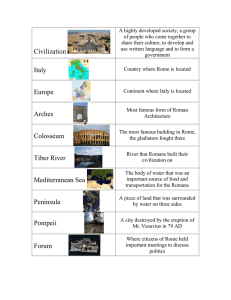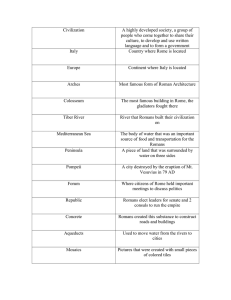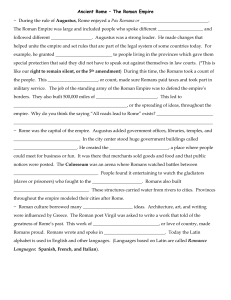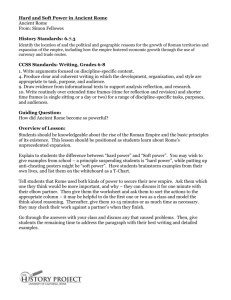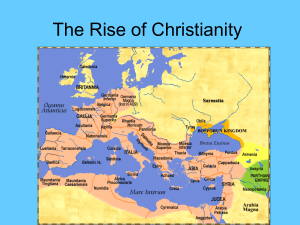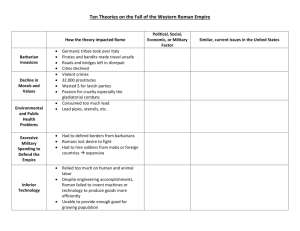Roman Empire Interesting Facts
advertisement
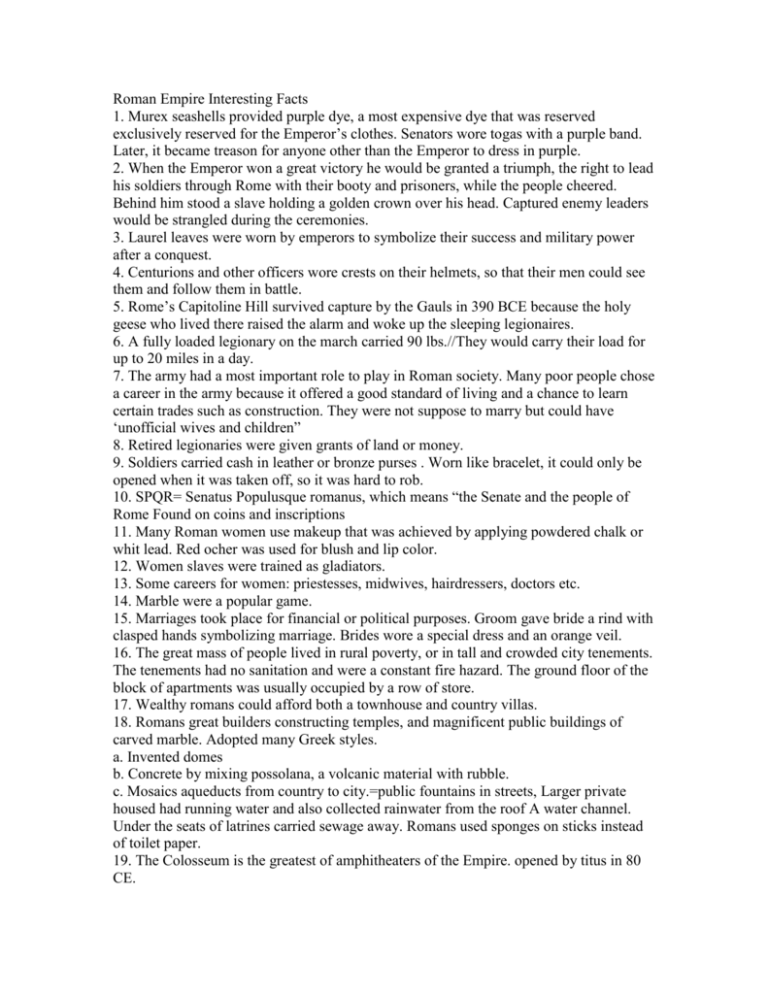
Roman Empire Interesting Facts 1. Murex seashells provided purple dye, a most expensive dye that was reserved exclusively reserved for the Emperor’s clothes. Senators wore togas with a purple band. Later, it became treason for anyone other than the Emperor to dress in purple. 2. When the Emperor won a great victory he would be granted a triumph, the right to lead his soldiers through Rome with their booty and prisoners, while the people cheered. Behind him stood a slave holding a golden crown over his head. Captured enemy leaders would be strangled during the ceremonies. 3. Laurel leaves were worn by emperors to symbolize their success and military power after a conquest. 4. Centurions and other officers wore crests on their helmets, so that their men could see them and follow them in battle. 5. Rome’s Capitoline Hill survived capture by the Gauls in 390 BCE because the holy geese who lived there raised the alarm and woke up the sleeping legionaires. 6. A fully loaded legionary on the march carried 90 lbs.//They would carry their load for up to 20 miles in a day. 7. The army had a most important role to play in Roman society. Many poor people chose a career in the army because it offered a good standard of living and a chance to learn certain trades such as construction. They were not suppose to marry but could have ‘unofficial wives and children” 8. Retired legionaries were given grants of land or money. 9. Soldiers carried cash in leather or bronze purses . Worn like bracelet, it could only be opened when it was taken off, so it was hard to rob. 10. SPQR= Senatus Populusque romanus, which means “the Senate and the people of Rome Found on coins and inscriptions 11. Many Roman women use makeup that was achieved by applying powdered chalk or whit lead. Red ocher was used for blush and lip color. 12. Women slaves were trained as gladiators. 13. Some careers for women: priestesses, midwives, hairdressers, doctors etc. 14. Marble were a popular game. 15. Marriages took place for financial or political purposes. Groom gave bride a rind with clasped hands symbolizing marriage. Brides wore a special dress and an orange veil. 16. The great mass of people lived in rural poverty, or in tall and crowded city tenements. The tenements had no sanitation and were a constant fire hazard. The ground floor of the block of apartments was usually occupied by a row of store. 17. Wealthy romans could afford both a townhouse and country villas. 18. Romans great builders constructing temples, and magnificent public buildings of carved marble. Adopted many Greek styles. a. Invented domes b. Concrete by mixing possolana, a volcanic material with rubble. c. Mosaics aqueducts from country to city.=public fountains in streets, Larger private housed had running water and also collected rainwater from the roof A water channel. Under the seats of latrines carried sewage away. Romans used sponges on sticks instead of toilet paper. 19. The Colosseum is the greatest of amphitheaters of the Empire. opened by titus in 80 CE. a. Arched vaults formed 80 entrance for the crowds, b. Huge canvas awning stretched over the top to provide shade and at night might hold a massive iron chandelier was suspended. c. Constructed to allow people to watch killing d. Aene had sand floor to absorb victims e. Hidden elevators and trap doors/Seats neared the front were reserved for the wealthy. f. Sea battles on lakes fought by gladiators were held g. Made of marble and statues were decorated the outside. Later, the Colleusm was looted and bronze and marble was taken for other buildings. h. 292,00 cartloads of Travertine stone used i. No definite cases are recorded of Christian martyrs dying j. Rebel slaves caught were nailed to cross. k. Gladiators would say” We who are about to die salute you!” Thumbs up or down? 20. Circus Maximus, a racetrack could seat 250,000 people. Would have 7 laps 21. Copied theater from Greece. Romans invented mime or pantomime. Actors word masks 22. People went to large public baths. Men and women had separate facilities. Sauna, changing rooms, exercise yard, game rooms. Olive oil was used for soap Fires stoked by slave from outside the bath building sent hot air under the floors and through hollow tiles in the walls to chimney in the roof..Had to wear wooden clogs for keep from burning their feet. 23. :Latin was spoke in West; Greek in the east. Romans introduced writing to northern Europe. Only 22 letters in the alphabet ( I and J , U V W Y did not exist) 24. Written on tablets Used Roman numerals Fine soot was mixes with water and other ingredients to make ink for writing on papyrus, wood or parchment. 25. Polished metal was used as mirrors. 26. Diet centered on bread, beans lentils. Large meal was inner. Celery popular. Wine mixed with water. Eggs, fruit such as apples, pears, figs, dates, plums and grapes; carrots, asparagus, lamb, pork fish cranes, parrots flamingoes and peacocks 27. Romans believed that illness could be caused by gods. Plants and herbs used (Ekecanoae used for digestion, fennel used to clam, sage ad powerful healer, Roman soldiers were fed a daily ration of garlic. Fenugreek used for treating pneumonia. After a plague in the third century, a temple to Aesculapius, god of healing was sited on island on Tiber River. 28. Survival did not go beyond 50 years old. Cremation first then burials. Cemeteries were outside of gates. 29. Names of our months have Roman origins 30. Believed that a goddess of chance, Fortuna controlled their lives 31. Medical quacks sometimes recommended gladiators blood as aid for fetility. 32. C;aigua (37-41 Ce tried to have his horse appointed as a Senator. 33. Roams washed their dished b rubbing them with sand then srinsing them in clean water. 34. The first living Roman to appear on a coin was Juluus Caesar after he seized power in 49 BXE. 35. Rome was not only the capital of the Empire but eh lagest city with a populations of more than 1 million in 1 CE. 36. The first ever shopping mal was built by Emperor Trajan in Rome. Arranged over several levels, it contained more than 150 outlets selling everything from foods to luxury silks and spice.es The VIA APPIA was the first road in a spphiscticated network that eventutally covered 60,000 miles and connected Rome with al the important towns of the Empire. 37. Tehe scholar Tutus LIvius (Livy) wtoea shistory of Rome that filled 142 boosk )35 survived)
